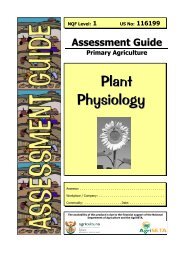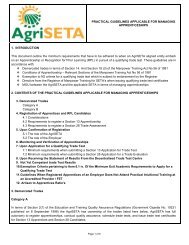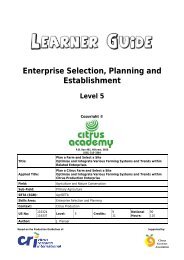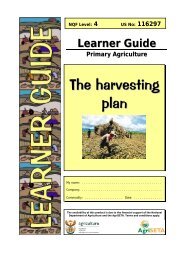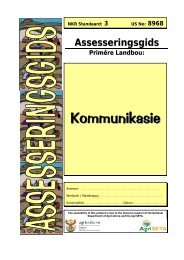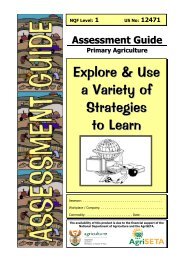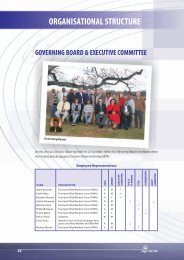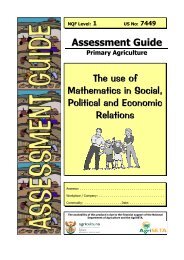Evaluate Basic External Animal Anatomy and Morphology - AgriSETA
Evaluate Basic External Animal Anatomy and Morphology - AgriSETA
Evaluate Basic External Animal Anatomy and Morphology - AgriSETA
- No tags were found...
Create successful ePaper yourself
Turn your PDF publications into a flip-book with our unique Google optimized e-Paper software.
<strong>Evaluate</strong> <strong>Basic</strong> <strong>External</strong> <strong>Animal</strong> <strong>Anatomy</strong> <strong>and</strong> <strong>Morphology</strong>Primary Agriculture NQF Level 1 Unit St<strong>and</strong>ard No: 11617333 The thoraxThe thorax is made up of three segments. The firstsegment (just behind the head) is called the collar. Thefollowing can be found on the thorax:• The legsThere are three pairs of legs. The biggest pair (rear legs) is used forjumping. The other two pairs of legs are used mainly for climbing tothe perch when the locust is in a resting position.• The wingsTwo pairs of wings are attached to the thorax. The first pair is narrow,hard <strong>and</strong> straight: they are joined to the second segment <strong>and</strong> in theresting position they lie parallel to the body.The second pair is thin, membranous <strong>and</strong> roughly triangular. They arefolded under the first pair when the locust is at rest <strong>and</strong> are almostinvisible. The second pair of wings is used for flying.• The spiracles (holes used to breathe)Two pairs of breathing holes are found on the thorax. The abdomenThe abdomen is made up of clearly defined segments. Thefirst segment of the abdomen is joined to the last segmentof the thorax. Each of the following segments consists ofan upper <strong>and</strong> a lower portion joined by a softer fold ofchitin. In the female the abdomen ends in four pointedstructures, which together form the ovipositor. Theovipositor is used both to make holes in s<strong>and</strong>y soil <strong>and</strong> tolay the eggs in the holes. The male is smaller than thefemale <strong>and</strong> its abdomen has a blunt end. The following structures arefound on the abdomen.• The tympanumAn oval membrane can be seeing on the first segment. This is thetympanum, which helps the locust to hear.• The spiracles (holes used to breathe)There are eight pairs of spiracles on the abdomen in all. They look likesmall black spots on the lower edge of the upper part of the abdomen.Version: 01 Version Date: July 2006



